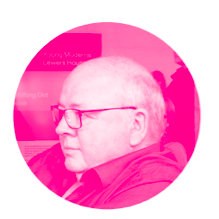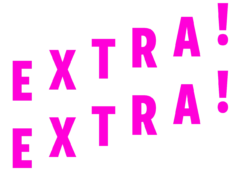by Ian Milliss
Ian Milliss is an artist who worked on Wrapped Coast.

In a recent interview the American feminist theorist Donna Haraway commented on the necessity for play in the way we approach developing solutions to the world’s imminent environmental disaster. “Play captures a lot of what goes on in the world” she said. “We need to develop practices for thinking about those forms of activity that are not caught by functionality, those which propose the possible-but-not-yet, or that which is not-yet but still open.”
Similar thought lay behind the development of this short term newspaper. When initially commissioned to run a Kaldor Studio project Lucas Ihlein proposed a series of printing workshops with Rizzeria, an organisation he had helped found in the dim distant past of 2008. He also proposed producing a weekly newspaper demonstrating the possibilities of riso print technology usually associated with zine culture. The newspaper would play off various Kaldor projects, giving them more context but also a contemporary response.
But it was soon obvious that the task was enormous. There was such a wide range of possible responses to the Kaldor projects, and the fifty years over which they occurred are arguably the most important in human history, marked by enormous social, cultural and technological change, as well as the realisation of the almost certain destruction of that same society within the next century.
Producing even a small weekly newspaper is no easy task, requiring many different specialised skills. So Lucas called in artist Ian Milliss, a collaborator who had professional newspaper publishing experience, and they set about quickly recruiting a team of journalists and artists to work with.
It became clear in our discussions that this project stood at the nexus of two critical areas of cultural change.
On the one hand, from the late 1960s, when Kaldor Public Art Projects began, art became increasingly unhitched from specific media or activities, and what was called the institutional definition of art took hold. In other words anything could be art as long as a consensus of art world institutions accepted it as art. At the same time what was called institutional critique also developed as artists began to make art which looked critically at those institutions and how they worked, leading eventually to current contemporary art which investigates all manner of social and cultural activities and presents them back to the public in a wide range of media.
On the other hand investigative journalism, which had always existed to a degree, became a major form of newspaper journalism. The 1970s to the 1990s can almost be seen as the pinnacle of print journalism, ringed around by the “rivers of gold” delivered by classified advertising. The development of the internet and its accessibility as an almost free platform for distributing information brought that to an end. There was no reason to buy a newspaper for its journalism if you could get the same information free online. Newspaper circulations dropped, advertising revenues plummeted and the quality of journalism declined as its financial base disappeared.
It was often commented over the last ten years, as journalists suffered massive redundancies, that journalists now faced the same plight as artists in the form of precarious or non existent employment at low wages, all becoming freelancers who had to compete by developing their own brand in the form of specialty areas and crowd sourced patrons while also subsidising their journalism with other activities.
Has art now become like investigative journalism? And has journalism has become a free range cultural activity like art? If so, how can we play with this? What if we bring them together in an art context with art freedoms and restraints and see what comes out of it? How will the results compare to the traditional production of both activities?
The newspaper we imagined is not quite a normal newspaper.
- It will initially be almost handmade rather than mass-produced, an exclusive product with a limited print run of only fifty copies. There will be only five editions of eight pages, although we hope to then compile it into a single forty page mass-produced version with a print run of several thousand, to be given out free during the remainder of this exhibition.
- The audience will be the limited audience of the art world rather than the general public audience sought by most newspapers.
- It will be produced under the economic limitations of art production. Contributors will be paid a minimal set fee, many will be volunteers.
- They will have the freedom to choose their own subject but, as always with artistic freedom, they will be curated into certain general thematic areas. In other words, opinions will be theirs, not necessarily endorsed by the editors, Kaldor Public Art Projects or the Art Gallery of NSW.
- It will connect to Kaldor Public Art Projects by providing a wider context to the fifty years of projects, linking the projects to other social and cultural change during that period, and teasing out barely visible aspects of some of the projects.
- It will be more an artwork than a newspaper, so it will tend to cultural interpretation rather than the political or economic and we hope the limitations in some areas will be balanced by imaginative flights and some futurology in others. Our wildest hope is that it will be a prototype, a sketch for a range of similar projects, as has occurred with our earlier agricultural projects.
- Although the potential themes are more than we can realistically cover we will tend towards several major areas: the growing understanding of public art’s relationship to land reflected in the contrast between Wrapped Coast in 1969 and Jonathon Jones’ barrangal dyarac (skin and bones) project in the Royal Botanic Gardens in 2016; the changing recognition of women artists and feminism in general; and the transformation of culture as labour, as seen through live art, media, and its institutions and histories.
- Above all we want to have some fun, with histories and with ideas.
In her interview, Donna Haraway emphasised a hope that we could develop ways to bring about a better future, to save ourselves by searching for possibilities:
It seems to me that our politics these days require us to give each other the heart to do just that [play]. To figure out how, with each other, we can open up possibilities for what can still be. And we can’t do that in a negative mood. We can’t do that if we do nothing but critique. We need critique; we absolutely need it. But it’s not going to open up the sense of what might yet be. It’s not going to open up the sense of that which is not yet possible but profoundly needed.
That is exactly what we also hope EXTRA!EXTRA! can be part of in its own modest way.
